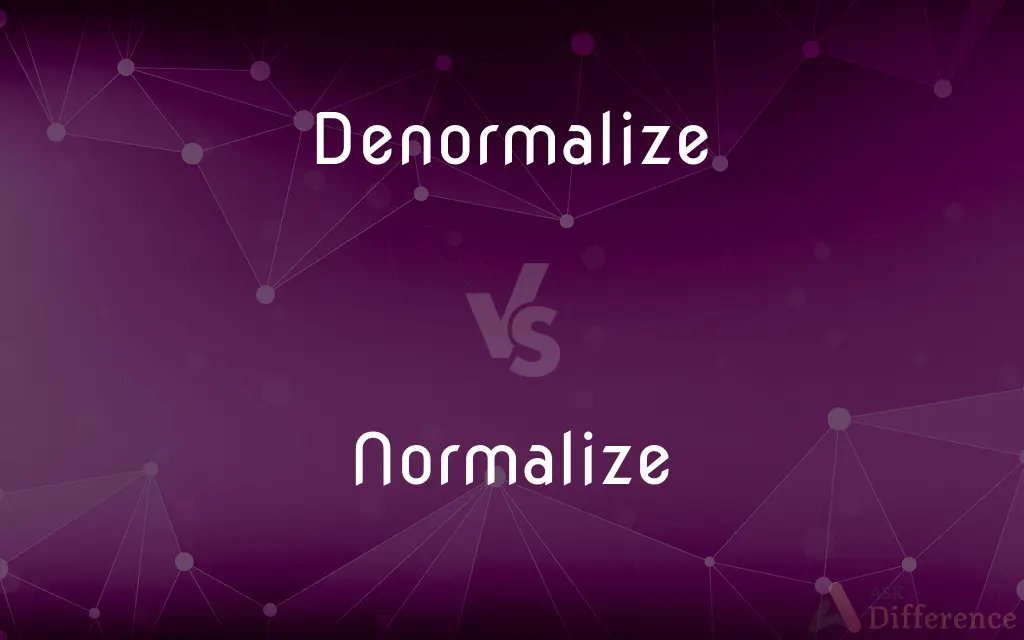Denormalize vs. Normalize — What's the Difference?
By Maham Liaqat & Fiza Rafique — Updated on April 8, 2024
Denormalization adds redundancy to speed up complex queries, while normalization organizes data to reduce redundancy and improve integrity.

Difference Between Denormalize and Normalize
Table of Contents
ADVERTISEMENT
Key Differences
Denormalization involves adding redundant data into a database to speed up read-heavy operations, allowing for quicker access to data at the cost of increased storage space and potential data integrity issues. Normalization, on the other hand, focuses on organizing data to minimize redundancy and ensure data integrity. By dividing data into multiple related tables, normalization reduces data duplication and promotes data integrity by ensuring that updates, inserts, and deletes are easier to manage.
This approach of denormalization is often used in systems where read operations far outnumber write operations, making it a preferred method in data warehousing and reporting applications where performance is critical. This method of normalization is beneficial in transactional databases where data integrity and consistency are more critical than read operation speed.
While denormalization can improve query performance by reducing the number of joins needed to fetch related data, it also makes the database more complex to maintain, as changes in data have to be managed across multiple places. This can increase the risk of data anomalies and integrity issues. Normalization simplifies database maintenance by centralizing updates in a single location, thereby reducing the risk of data anomalies. However, this can lead to more complex queries that require multiple joins to reconstruct the needed information, potentially impacting query performance.
Denormalization is often applied after normalization in a strategic manner to optimize read operations, especially in scenarios where data volume and query complexity make direct normalized queries inefficient. It's a balance between storage space and performance, tailored to specific use cases. Normalization is foundational in database design, ensuring that databases are efficient, maintainable, and scalable. It's the starting point for most database designs, which can later be adjusted through denormalization based on performance needs and usage patterns.
Comparison Chart
Objective
Speed up read operations
Reduce data redundancy, improve data integrity
ADVERTISEMENT
Data Structure
Adds redundant data
Organizes data into related tables
Use Case
Read-heavy operations, data warehousing
Transactional databases, where data integrity is crucial
Maintenance
More complex, higher risk of data anomalies
Simpler, centralized updates reduce anomalies
Performance
Improved read speed, larger storage requirement
May require complex queries, but ensures data integrity
Compare with Definitions
Denormalize
To incorporate redundant information into a database to improve query performance.
A customer table in a denormalized database might include order details directly, reducing the need for joins.
Normalize
Organizing data into tables to minimize duplication.
Normalizing a database involves creating separate tables for users and orders.
Denormalize
Strategy used in data warehousing to enhance data retrieval speed.
Denormalization is common in data warehouses to speed up analytical queries.
Normalize
Method to enhance data integrity and consistency.
Normalization ensures that updates to a user's address are made in one place.
Denormalize
A method to optimize read operations at the expense of data integrity.
Denormalizing a database can make updates more complex due to data duplication.
Normalize
Technique to reduce database maintenance challenges.
Through normalization, database anomalies during updates are minimized.
Denormalize
Adding duplicate data intentionally to a database design.
Denormalization can result in quicker query responses by duplicating critical information.
Normalize
Reducing data redundancy through table separation.
Normalization can lead to more complex queries due to the separation of data into different tables.
Denormalize
Process of adding data redundancy to reduce the number of joins.
Denormalizing a database might involve adding a user's name to each order record.
Normalize
A process to structure a database according to normalization rules.
Database normalization often leads to a design that reduces data redundancy.
Denormalize
To add redundancy to (a database schema), the opposite of normalization, typically in order to optimize its performance.
Normalize
To make normal, especially to cause to conform to a standard or norm
Normalize a patient's temperature.
Normalizing relations with a former enemy nation.
Denormalize
(transitive) To make no longer normal; to treat or regard as different or unusual.
Normalize
To cause (something previously regarded as anomalous) to be accepted as normal, thereby altering the accepted norm
“The increased visibility of Iraq War amputees has helped normalize the use of prostheses” (Bruce Barcott).
Normalize
To make (a text or language) regular and consistent, especially with respect to spelling or style.
Normalize
To remove strains and reduce coarse crystalline structures in (metal), especially by heating and cooling.
Normalize
To become or return to normal
Waiting for diplomatic relations to normalize.
Normalize
(transitive) To make normal, to make standard.
There is little hope that the two countries will normalize relations; their governments seem to hate each other and would just as soon stay on bad terms.
Normalize
(transitive) To format in a standardized manner, to make consistent.
We'll need to normalize these statements before we can compare them.
Normalize
To reduce the variations by excluding irrelevant aspects.
After we properly normalize the measurements with respect to age, gender, geography and economic considerations, there remains little evidence of a difference between the two groups.
Normalize
To return a set of points (switches) to the normal position.
Normalize
To return to the normal position from the reverse position.
Normalize
To subject to normalization; to eliminate redundancy in (a model for storing data).
Normalize
To anneal (steel) for the purpose of decreasing brittleness and increasing ductility.
Normalize
To divide a vector by its magnitude to produce a unit vector.
Normalize
To make normal; as, to normalize relations with China.
Normalize
To make standard; determine the value by comparison to an item of known standard value; as, The test results were normalized for changes in the number of questions before comparison with the previous year's values.
Normalize
To convert to a standard form or measure; adjust the value or values so as to conform to a standard measure or pattern; as, The probabilities were normalized to add up to 1.00.
Normalize
Become normal or return to its normal state;
Let us hope that relations with this country will normalize soon
Normalize
Make normal or cause to conform to a norm or standard;
Normalize relations with China
Normalize the temperature
Normalize the spelling
Normalize
Toughen (steel or glass) by a process of gradually heating and cooling;
Temper glass
Common Curiosities
What is denormalization?
Denormalization is the process of introducing redundancy into a database design to improve read operation performance.
When is normalization used?
In the initial stages of database design to ensure data integrity and reduce data duplication.
What is normalization?
Normalization is a database design technique that organizes data into tables to reduce redundancy and improve data integrity.
Why would you denormalize a database?
To improve the speed of query operations, especially in read-heavy systems like data warehouses.
What are the advantages of normalization?
Reduces data redundancy, ensures data integrity, and simplifies database maintenance.
What are the drawbacks of denormalization?
Increased storage space requirement and a higher risk of data anomalies.
What is a common use case for normalization?
Transactional databases, where maintaining data integrity for updates, inserts, and deletes is crucial.
Is denormalization suitable for all databases?
No, it's more suited for databases where read performance is prioritized over write operations, like in reporting and data analysis.
Can denormalization affect data integrity?
Yes, because introducing redundancy can lead to inconsistencies if not managed carefully.
What is the impact of denormalization on storage?
It increases the storage requirement due to the duplication of data.
How does normalization affect database performance?
While it can make data updates more efficient, it may require complex queries with multiple joins, potentially impacting read performance.
Can a database be both normalized and denormalized?
Yes, a database can be initially normalized for integrity, then selectively denormalized for performance optimization.
How does normalization contribute to data integrity?
By organizing data in such a way that updates, inserts, and deletes are managed in a single location, reducing anomalies.
How do you decide between normalization and denormalization?
The decision is based on the specific needs of the application, considering factors like query speed, data integrity, and storage.
Is denormalization always the solution for slow queries?
Not always; it's one strategy to improve read performance, but it must be balanced with considerations for data integrity and storage.
Share Your Discovery

Previous Comparison
Hypoventilation vs. Hyperventilation
Next Comparison
Chubby vs. SkinnyAuthor Spotlight
Written by
Maham LiaqatCo-written by
Fiza RafiqueFiza Rafique is a skilled content writer at AskDifference.com, where she meticulously refines and enhances written pieces. Drawing from her vast editorial expertise, Fiza ensures clarity, accuracy, and precision in every article. Passionate about language, she continually seeks to elevate the quality of content for readers worldwide.














































